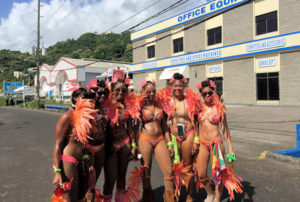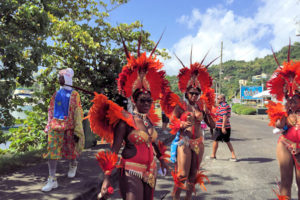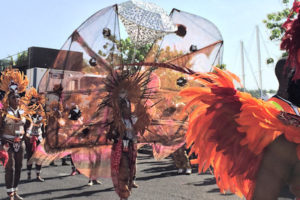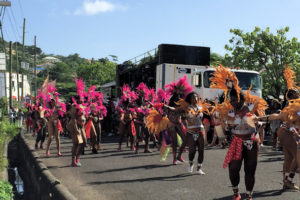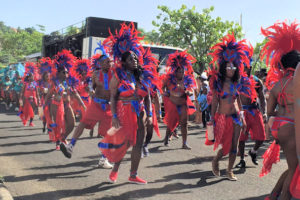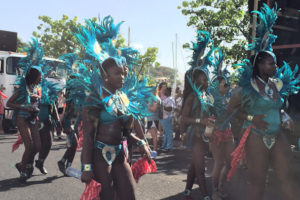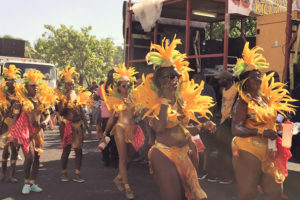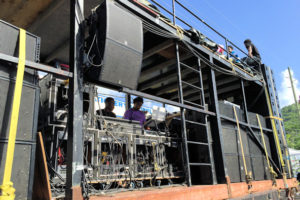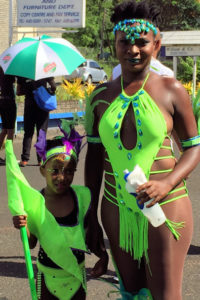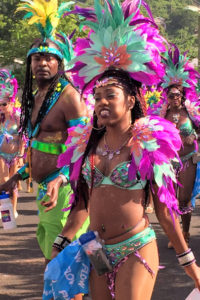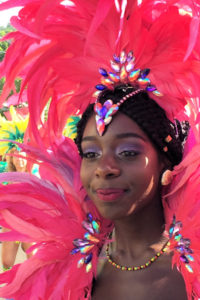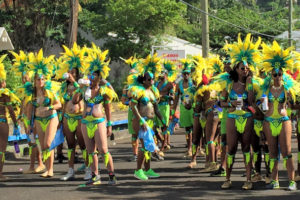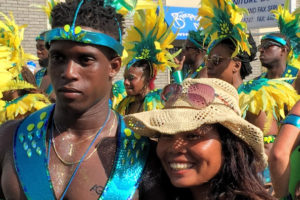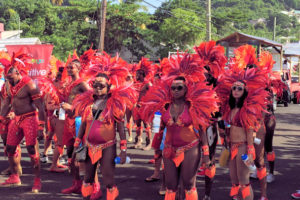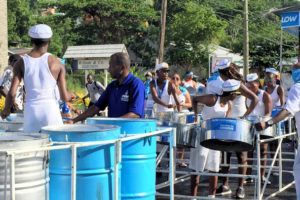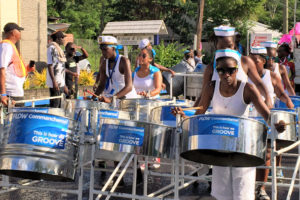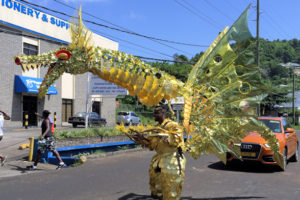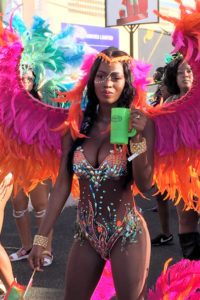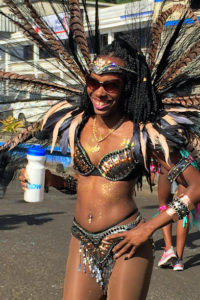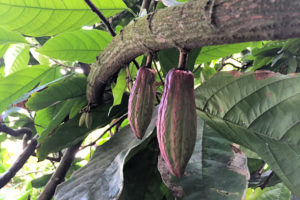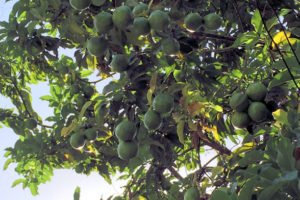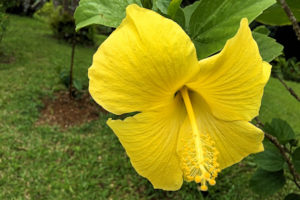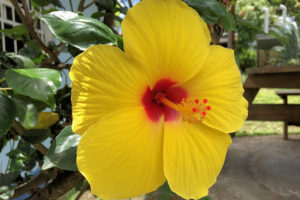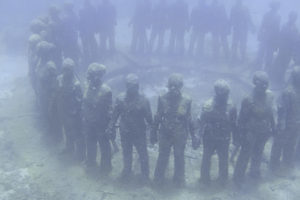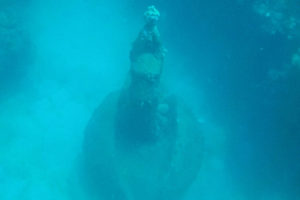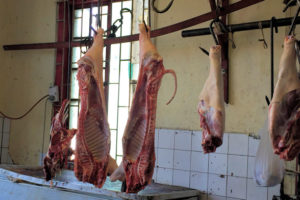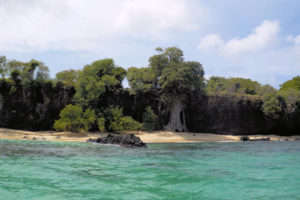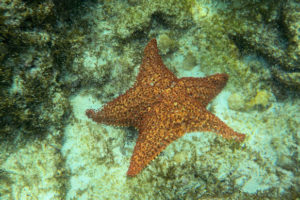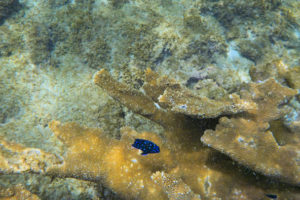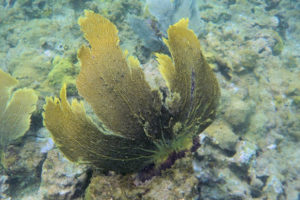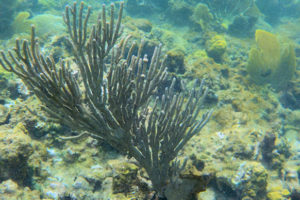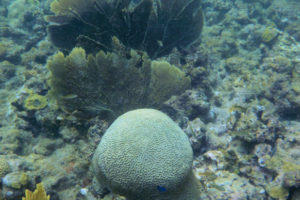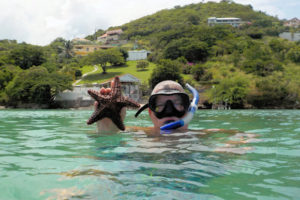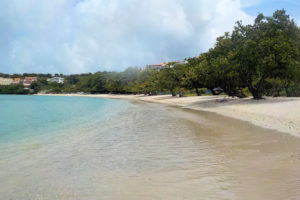August – October 2016: Port Louis Marina, Grenada
We spent three and a half months in Grenada, all at the Port Louis marina. We spent our time fixing some things on the boat, hanging out with friends, lounging in the pool, touring the island, and in general, a whole lot of liming – it was too hot to be highly industrious.
Carnival
The big event in Grenada is Carnival, which takes place in early August. The festival culminates on the last Monday and Tuesday of Carnival Week. On Monday morning, Jouvert starts at 3AM. This festival consists of the loudest music we have ever heard, and the masqueraders smear themselves with used motor oil and paint, partying until they pass out. We were warned that it would be really loud, but we were confident that being in the berth with the a/c on would insulate us. We could not have been more wrong. The music started up at about 2:30, and we both bolted out of bed. It was so loud, the boat was vibrating. There was a flatbed truck loaded with speakers, aimed at us from about a half a mile away, and it was still amazingly loud. We stayed in, but we weren’t able to get any more sleep. Scott and Noi, and well as Brian and Lauren, decided to join the festival. The marina set up a hose outside of the bathrooms for washing off, as they did not want people tracking oil into the showers. Here’s a link to one couples’ experience. We decided to pass on this wonderful experience.
We did take part in the Monday Night Mas parade, as part of the Carib band. There are a series of parades, and we found out that most cruisers join the Carib “band” for the Monday Night Mas parade. That consists of getting Carib gear (tee-shirt, hat, lights, and lit saber) and simply showing up. Given that it was at night, it sounded good to us. With Scott and Noi, we went to the brewery to get our gear, but once there, it looked like a small riot was happening. We had already signed up and paid in advance, so we joined the queue outside the gate. After some time, we learned that the people we were waiting with had not paid in advance, and that we could go inside the gate to get our stuff. And that’s when we saw the riot. The office were they were handing out the swag was besieged, again by people that had no reservation – apparently joining the Carib band was a big deal! We politely made our way through the throng, and we eventually got our stuff.
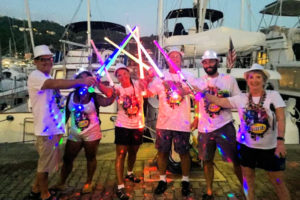 We were not sure where to go to join the parade – we heard a variety of opinions, ranging from the IGA a long way up the beach road, to outside of the marina. We knew that the route went right past the marina, so we decided to start walking up the road than flanked the west coast. It was full of party revelers, and we saw a lot of people with Carib shirts on, so we knew we were on the right track. After fifteen or twenty minutes, we found the Carib truck. We got some of the free beer, and found some places to party with our Carib friends. We also ran into Brian and Lauren, as well as Gregg and Jo from Serenade. We had no idea when the parade would start, and we didn’t really care. Carnival music was blasting from the truck – it’s a pounding 4/4 beat that never stops, and it’s impossible to tell when one song ends and another starts. But again, we didn’t much care. Eventually, the parade started to move. We could move back and forth to the beer truck for refills, not without some difficulty due to the size of the parade. After some time, we stopped, and the bandleader gave us our instructions. When we reached the judging stand, we were to follow his directions, waving our light sabers in preset patterns. It wasn’t complicated, even for us drunks. It probably took an hour and a half to get to the judging stand, which wasn’t too far past the marina. We executed our snazzy routine, and a little after that, we decided to call it a night, and walked back to the marina. It was about 1:00AM when we got back. We danced, drank free Carib, and waved around our light sabers, and in general had a great time. We’re in there somewhere!
We were not sure where to go to join the parade – we heard a variety of opinions, ranging from the IGA a long way up the beach road, to outside of the marina. We knew that the route went right past the marina, so we decided to start walking up the road than flanked the west coast. It was full of party revelers, and we saw a lot of people with Carib shirts on, so we knew we were on the right track. After fifteen or twenty minutes, we found the Carib truck. We got some of the free beer, and found some places to party with our Carib friends. We also ran into Brian and Lauren, as well as Gregg and Jo from Serenade. We had no idea when the parade would start, and we didn’t really care. Carnival music was blasting from the truck – it’s a pounding 4/4 beat that never stops, and it’s impossible to tell when one song ends and another starts. But again, we didn’t much care. Eventually, the parade started to move. We could move back and forth to the beer truck for refills, not without some difficulty due to the size of the parade. After some time, we stopped, and the bandleader gave us our instructions. When we reached the judging stand, we were to follow his directions, waving our light sabers in preset patterns. It wasn’t complicated, even for us drunks. It probably took an hour and a half to get to the judging stand, which wasn’t too far past the marina. We executed our snazzy routine, and a little after that, we decided to call it a night, and walked back to the marina. It was about 1:00AM when we got back. We danced, drank free Carib, and waved around our light sabers, and in general had a great time. We’re in there somewhere!
On Tuesday afternoon, the Pageant, or Pretty Parade takes place, starting just outside our marina. There were tons of masqueraders in elaborate carnival costumes, but the heat was oppressive – every dancer had water bottles, and even they were being cautioned to meter their alcohol intake! “Organization” is a word that has no meaning in the Caribbean. The parade was supposed to start at 1:00, but it was 2:30 before anything happened. Even at that, a couple of troupes came through, and then everything ground to a halt again. Finally, at around 3:00 (the hottest part of the day), the parade action picked up. We were just across from the judging stand, so we got a great view. We took a ton of pictures, and the masqueraders were delighted to indulge our cameras. One odd thing that I noticed was that most of the women were wearing pantyhose under their costumes. I suppose they did it for modesty, but it certainly looked hot.
Cutty’s Island Tour
Scott’s son Eric came down for a visit, and we joined them for an island tour with Cutty (Cuthbert McMeo). AfterMath had gone with Cutty, and they highly recommended the tour. Cutty was an expert on both the ecology and history of the island, and we thoroughly enjoyed the day. First stop was up on a hill overlooking St. George’s, which also happened to be the location of the island’s prison.
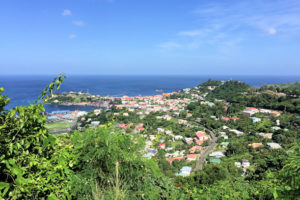
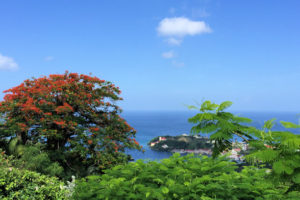
Views from the prison yard area
After taking snaps of the panoramic view, we drove into the forest, where Cutty stopped to give us an insight into the many, many spices and plants that grow wild in Grenada. We would snap a leaf in two, and ask us to guess the spice. We identified cinnamon, cloves, allspice, and bay leaf. In addition, he pulled up roots of wild ginger and turmeric (saffron). There were cocoa, orange, grapefruit, and avocado trees. The wild oranges in Grenada are green, so I’m not sure how they qualify as oranges. Elsewhere we would see nutmegs, cashews, papayas, and of course, mangoes. The forest smelled delicious!
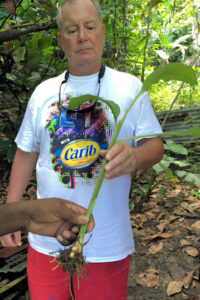
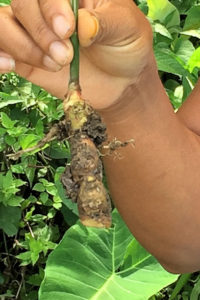
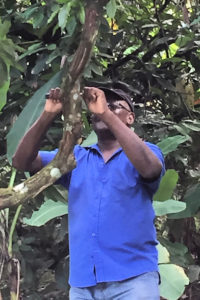
Lucky eyeing saffron Wild ginger root Cutty scraping some cinnamon bark
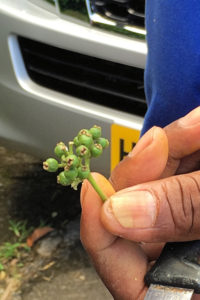
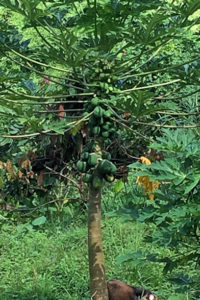
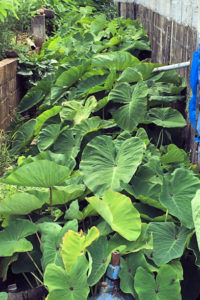
Allspice Papaya tree Callalou, a type of spinach
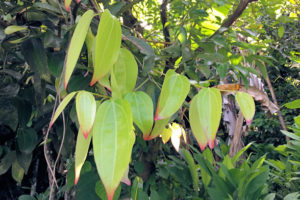
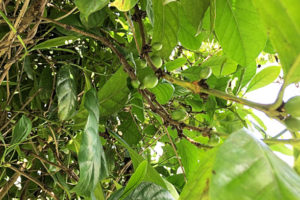
Bay leaves Guinep – a kind of lime
Driving out of the forest, we came to Annandale Falls, the most visited waterfall in Grenada. It’s just off of a main road, so it’s common to see a lot of tourists there. One enterprising guy brings his pet monkey, a Mona monkey. These are not native to the island, but they have been on the island since the 18th century – they are thought to have arrived on a ship from Ghana. This monkey calmly sits on people’s shoulders for photos and tips – but I think the monkey’s tip share is peanuts.
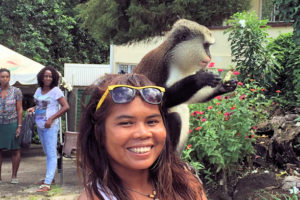
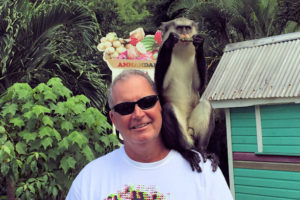
We’re hoping the monkey doesn’t … well, you know
The falls are easily accessed over a short, paved trail. There are more enterprising Grenadians jumping into the falls from the highest point. They also ask for tips, although they don’t have to share them with a Mona monkey. There is a platform for tourists to jump off of – I would guess it’s about twenty-five feet above the pool. It’s not scary, but I made a rookie mistake when I jumped in – I failed to breathe out of my nose when I hit the water, so I got a snootfull of it. The water was refreshingly cool, and we stayed to enjoy the refreshment.
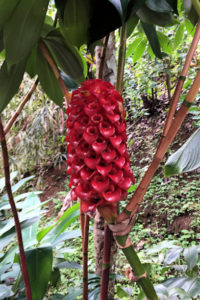
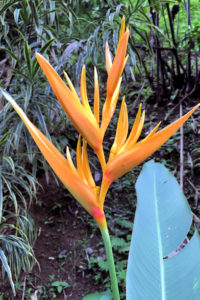

Flora along the path to the falls
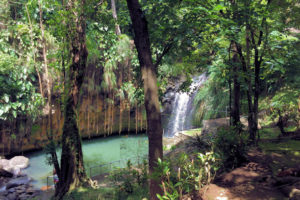
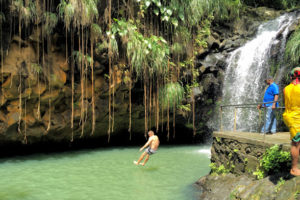
Annandale Falls Scott takes the plunge
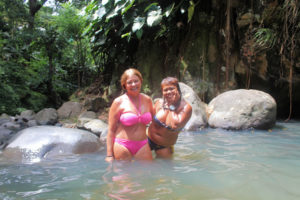
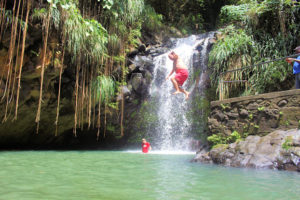
Lovely ladies in the pool Lucky’s not-so-graceful leap
We continued the drive through the interior, peaking at Grand Etang Lake, a crater lake in an extinct volcano at an elevation of 1,800 feet. Cutty tried to call the monkeys that are wild in this area, but they were otherwise occupied.
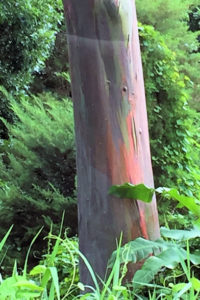
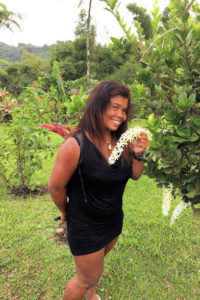
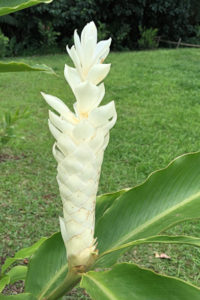
Blue mahoe tree Coy Noi Defying gravity
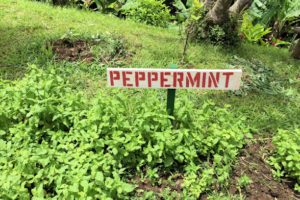

Yes, this grows in Grenada Grand Etang Lake – ancient crater
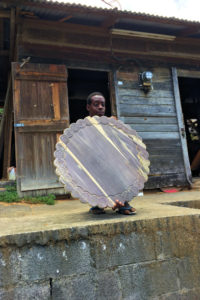 One of the most unusual trees on the island is the blue mahoe, a hardwood tree similar to mahogany. The wood is grayish with streaks of blue in it. After leaving the forest, we stopped at a local furniture maker, and he showed us a table made of blue mahoe – it was very stunning.
One of the most unusual trees on the island is the blue mahoe, a hardwood tree similar to mahogany. The wood is grayish with streaks of blue in it. After leaving the forest, we stopped at a local furniture maker, and he showed us a table made of blue mahoe – it was very stunning.
Once we descended from the forest, came across a river that supposedly featured tubing. Looking at that river, we guessed that there would be a lot more walking than tubing, with a real danger of butt splinters. Scott had been considering tubing with Eric, but not after seeing the river.
We then stopped at the River Antoine Rum distillery for lunch, followed by a tour. This distillery has been making overproof rum since 1785. Little has changed at the distillery – it still uses no electric power, operating only when the river is flowing.
River Antoine makes their pure cane juice rum from locally grown, hand cut, organic sugar cane. The juice is extracted by crushing the stalks multiple times in a waterwheel-powered cane crusher. The steady rush of water that turns the wheel is diverted from a local river and depending on whether it’s rainy or dry season, is only allowed to flow for a few hours per day.
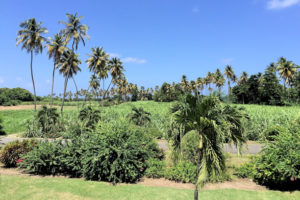
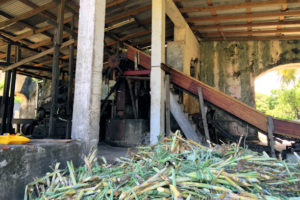
Grounds of the River Antoine distillery The cane crushing room
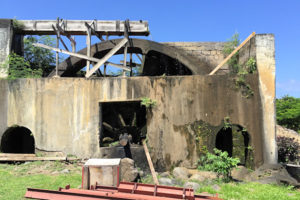
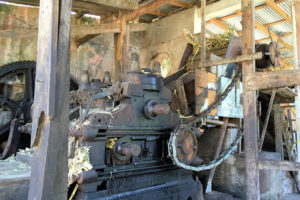
Water runs the cane crushing wheel The machinery is really old
Once the cane has been crushed and the juice extracted, the juice runs via gravity into the boiling room, which is fueled by the dried cane stalks. Once the juice has been boiled into a syrup, it is passed into the fermentation room. This is the one area that has been “modernized” – the fermentation vats are concrete, replacing the original wooden ones. Fermentation is accomplished naturally, without added yeast.
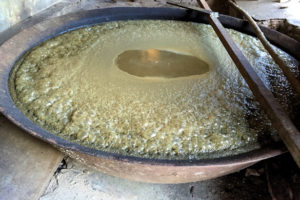
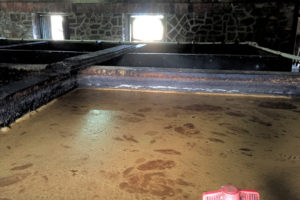
Boiling cane juice Fermentation tanks
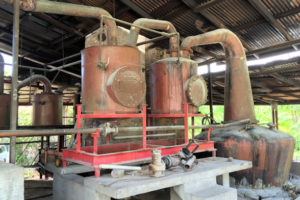
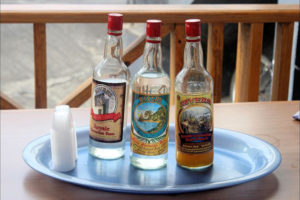
Pot stills The finished products – not allowed on planes!
After distillation, the fresh rum is gravity fed to a neighboring room where its ABV is verified and the tax man keeps it under lock until proper documentation is made. It is bottled using a Rubbermade water cooler with a spigot, then hand sealed and labeled. The entire process is very green and almost unintentionally “artisan.”
From cane to rum takes about eight days – there is no aging of this fire water. The minimum proof is 150 (75%), and some batches are in the 85% range. At the completion of the tour, we were given the “opportunity” to taste the finished, and very potent potable. It tasted like pure fire going down. It’s beyond me how locals can sip and enjoy this stuff. They were also making a 20% rum punch and chocolate rum, both of which were quite tasty.
Next was the visit to the chocolate factory. We stopped at a place where the cocoa farmers bring the pods, where the beans are extracted, fermented, and dried. The beans in a fresh pod are actually white – they turn brown after aging and drying. The characteristic brown color and rich aroma develop as the beans ferment. During the fermentation process, which takes several days, naturally occurring yeasts consume the sugars in the sweet pulp that surrounds the cocoa beans. This causes the pulp to break down, creating natural enzymatic changes in the beans.
The beans are spread out on large wooden trays, where they dry slowly, under the sun. (The trays can be rolled under a roof in case of rain.) These beans were dried using the time-honored tradition of “walking” the beans – they are turned by gently walking over them, a method introduced by the French hundreds of years ago. At this point, the beans are still in their shells, which are later roasted and removed.
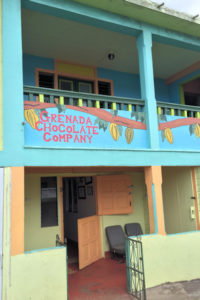
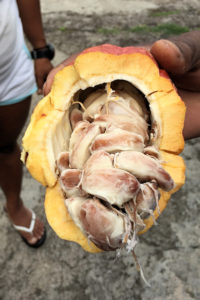
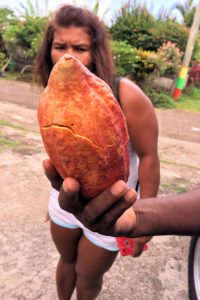
The “factory” The ripe beans are white Noi sizing up a cocoa pod
Once the beans are ready, they are delivered to the chocolate factory – there are several on the island. We visited the Grenada Chocolate Factory, which looks like a house. Inside, they process the chocolate from beans to the finished product.
Although the quality of cocoa is influenced by every step in the production process, roasting is especially important for developing the flavor of chocolate. The beans are carefully roasted in small batches, adjusting time (usually about an hour) and temperature in accordance with size and other characteristics, to allow the unique flavor of the beans to develop.
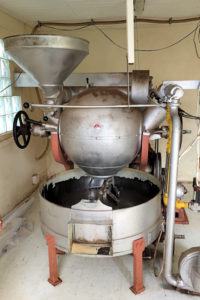
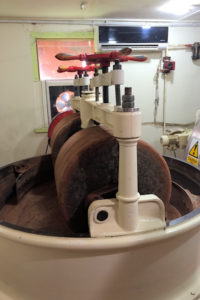
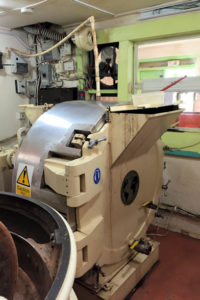
Stuff for making chocolate. The aroma was scrumptious!
The next step is called winnowing. In the winnower, the beans are broken up and the shells are removed through a combination of sifting and blowing. The bits that remain are called cocoa nibs, which have become a popular health food because of their rich nutritional value and bold cocoa flavor.
 The next step is to refine the chocolate into much smaller particles, and to introduce sugar. This process ensures a very smooth chocolate. Finally, a step called conching is done to smooth out the texture, using heavy rollers and heavy blades. This rounds out the chocolate’s flavor, and is used to create distinct taste profiles.
The next step is to refine the chocolate into much smaller particles, and to introduce sugar. This process ensures a very smooth chocolate. Finally, a step called conching is done to smooth out the texture, using heavy rollers and heavy blades. This rounds out the chocolate’s flavor, and is used to create distinct taste profiles.
This company offers chocolate bars with cocoa content ranging from 60% to 100%. I liked the 71%, which had a great dark chocolate flavor. The 100% was too bitter to be edible, but would be good for baking. Rosé prefers milk chocolate, but she liked the Nib-a-Licious, the 60% bar with cocoa nibs.
After the chocolate factory visit, it was off to the nutmeg processing facility. Along the way, we passed through some very small houses that looked pre-fabricated. Cutty called them “Janet houses” – they were built for homeless people after Hurricane Janet devastated the island in 1955. Some of them are still standing today, which is amazing.
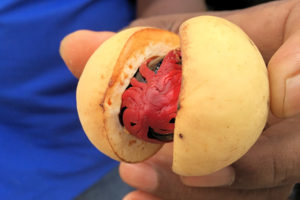 At the nutmeg processing plant in Grenville, we saw how nutmeg is processed, which is quite simple. The seeds are brought to this plant for drying. The outer casing is cracked open, and the mace, which is a lace-like covering over the inner seed, is extracted. Mace can be used as a spice to flavor baked goods, meat, fish, etc. The inner seed is then dried in tacks for up to two months. Once the seed rattles, it is ready for production. It can be sold whole, or ground up as a powder. Hurricanes have done a lot of damage to the nutmeg trees on Grenada – production is only about 10% of what it used to be. The trees were originally imported from Malaysia, so they are not native to Grenada.
At the nutmeg processing plant in Grenville, we saw how nutmeg is processed, which is quite simple. The seeds are brought to this plant for drying. The outer casing is cracked open, and the mace, which is a lace-like covering over the inner seed, is extracted. Mace can be used as a spice to flavor baked goods, meat, fish, etc. The inner seed is then dried in tacks for up to two months. Once the seed rattles, it is ready for production. It can be sold whole, or ground up as a powder. Hurricanes have done a lot of damage to the nutmeg trees on Grenada – production is only about 10% of what it used to be. The trees were originally imported from Malaysia, so they are not native to Grenada.
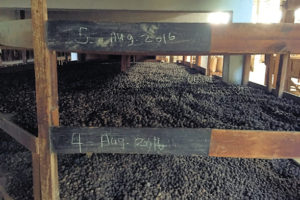
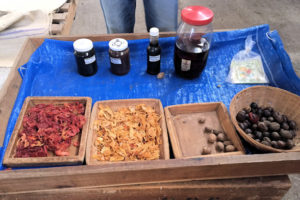
Drying racks for nutmeg seeds Products – mace and nutmeg
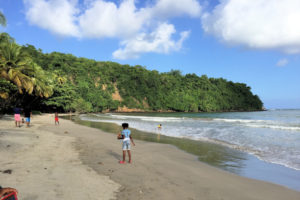 We started the drive back to St. George’s, traveling along the southeastern and southern coasts. We made a stop at La Sagesse Beach, a beautiful enclosed cove with the forest just behind it. Noi got a couple of low-hanging papayas, and Cutty showed her how to get lipstick from a plant – you break open the pod and crush the seeds, which yields an unbelievable bright red color. After that, we had Cutty drop us off at Scott’s favorite place for dinner.
We started the drive back to St. George’s, traveling along the southeastern and southern coasts. We made a stop at La Sagesse Beach, a beautiful enclosed cove with the forest just behind it. Noi got a couple of low-hanging papayas, and Cutty showed her how to get lipstick from a plant – you break open the pod and crush the seeds, which yields an unbelievable bright red color. After that, we had Cutty drop us off at Scott’s favorite place for dinner.
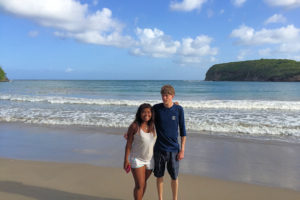
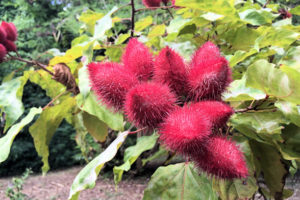
Noi and Eric The lipstick plant
Mt. Carmel Falls
A couple of days later, we decided to join Scott, Noi, and Eric for a bus trip and hike to Mt. Carmel Falls, on the east side of the island near the town of Grenville. These falls are the highest on the island. It took about forty minutes on the bus to get to the falls. Since they are on someone’s property, we had to pay a nominal fee to gain access. Immediately, we were joined on the hike by two dogs, who we named Mango and Nutmeg, of course. The hike was easy, and only about fifteen minutes through the forest. Once we arrived, there was only one other couple there, and they soon left. Noi did her best impression of a mountain goat, climbing nimbly to get underneath the falls. The water was on the cool side, but it was very refreshing. We found some wild mangoes to munch on, and Noi found some baby bamboo to take back with her. Nutmeg and Mango decided they were guarding us – after some time a local rasta guy showed up, and the dogs were rather menacing to him.
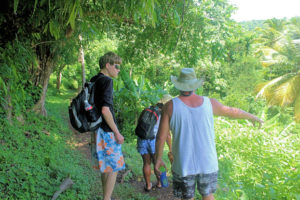
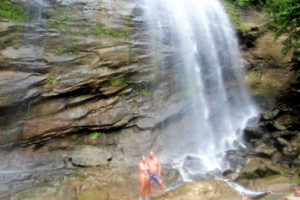
Starting the short hike Rosé and Lucky dwarfed by the falls
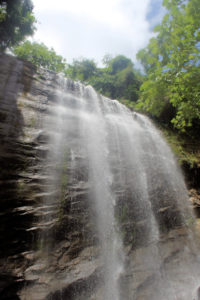
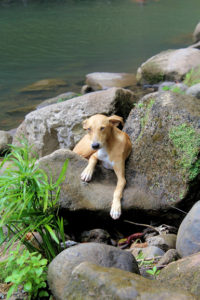
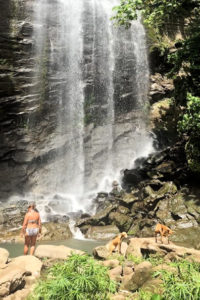
View up the falls Nutmeg – or Mango?
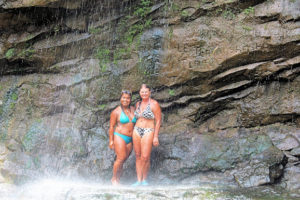
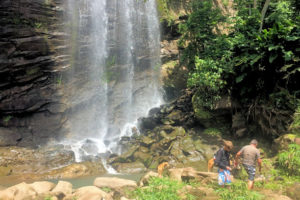
Two lovely ladies under the falls Eric, Noi, and our guard dogs
The Mango Festival
 We heard about the annual Mango Festival from some fellow cruisers, so we had to go for that one. It was held in the cricket stadium just north of St. George’s, which was a short walk from the bus station. The stadium itself was new and modern, and fortunately most of the festival booths were in the promenade area under the grandstand, or in tents around the outside. That morning was sunny and bright, and with all of the people there, it was stuffy and hot. Unfortunately, we didn’t seem to take many pictures, but it was a lot of fun, and we were surprised to see the variety of mango-related products.
We heard about the annual Mango Festival from some fellow cruisers, so we had to go for that one. It was held in the cricket stadium just north of St. George’s, which was a short walk from the bus station. The stadium itself was new and modern, and fortunately most of the festival booths were in the promenade area under the grandstand, or in tents around the outside. That morning was sunny and bright, and with all of the people there, it was stuffy and hot. Unfortunately, we didn’t seem to take many pictures, but it was a lot of fun, and we were surprised to see the variety of mango-related products.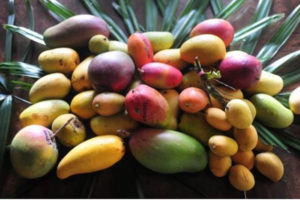
One of the highlights was the mango eating contest for kids – it was a riot, as there just is not a neat way to eat a whole mango. Someone was good enough to post a Youtube video of one of the rounds. We sampled mango ice cream, mango slushies, mango chutney, mango turnovers, well, you get the point. We also had a local lunch on the scene, and we ran into several cruisers that we had met along the way – Grenada is a real gathering point for full-time Caribbean cruisers.
Cooking classes at True Blue Resort
We learned that on Thursday afternoon, there was a cooking class offered at the True Blue Resort, which is located near the university on the southwestern side of the island. Coincidentally, it is a little past the West Indies Brewing Company, so you know where we went afterwards… Two cooks, Esther and Omega, ran the class, and there were usually some healthy disagreements between them on precisely the best way to make the dishes – it was entertaining. For people not staying at the resort, there was a nominal charge of EC$15, but that included eating the food that had been prepared. Most of the food was pretty good, although none of us cared that much for the oil down, which is the national dish. It doesn’t sound very appetizing, and the taste is strictly local. Scott wrote an article about oil down for NPR, which describes it in detail.
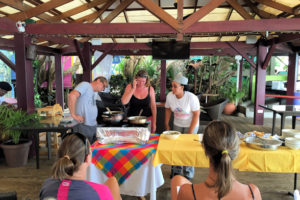

Scott wondering if that is really edible Esther and Omega
The resort was located on the finger of land that separates True Blue Bay and Prickly Bay, where Symbiosis was anchored.
Maintenance, maintenance, maintenance
In late August, Rose departed to visit her sister in Colorado, leaving Quincy and I to hold down the fort. There wasn’t much to do, but I did work to fix some damage on the bottom of Little Blend, as well as replacing the fuel filter, which had rusted out tabks to the flipping incident in St. Maarten. We also had a local guy wax the outside of the boat, which he spent his two-week vacation doing. In addition, we were having the headliners in the salon, pilothouse, and our berth replaced. The fabric had delaminated very rapidly, and we figured it would be less expensive to get it done in Grenada than Florida. Unfortunately, despite giving the upholsterer a sample of the existing fabric, he used a dimpled fabric instead of the smooth version that was originally installed. He also used a thicker foam. It didn’t look bad, but it didn’t match the fabric in the guest berth, but we decided it was oaky. I elected to have a diver clean the bottom and scrape the gunk off of the forward mooring lines, as the price was worth it for me not to get into the harbor water. A couple of times per week Scott and Noi would come by, usually with chicken. There was a KFC on the bus route from their boat – Noi really loved it, and she used feeding Quincy as an excuse to stop there for lunch. We had one other problem during our stay – the bilge pump stopped working. The air conditioning condensation drains into the bilge, and one day in the engine room I saw that the bilge was pretty full. We had a spare pump that we had picked up in Florida, which was much more robust than the one originally installed by Nordhavn. However, after I installed it, I realized that the float switch was not working either, so it did not pump automatically. The float switch didn’t look anything remotely like the one described in the manual, nor did it look anything like the inventory from the supplier. I was perplexed about it, and I decided to wait until we returned to St. Maarten to resolve the problem. In the meantime, I could run the pump manually as needed by watching the water level.
Grande Anse Beach
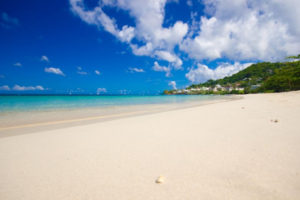 About five minutes away by bus was the best beach on the island – Grande Anse. It was a long, protected white sand beach, but without high rise hotels, so it never felt too crowded. There were a couple of nice beach bars at either end – Coconut Beach Restaurant on the north end, and Umbrella’s Beach Bar on the south end. Umbrella’s got pretty busy once the university students returned to school, but it still was a fun place for lunch. It was very close to the Spiceland Mall, location of the large IGA grocery store.
About five minutes away by bus was the best beach on the island – Grande Anse. It was a long, protected white sand beach, but without high rise hotels, so it never felt too crowded. There were a couple of nice beach bars at either end – Coconut Beach Restaurant on the north end, and Umbrella’s Beach Bar on the south end. Umbrella’s got pretty busy once the university students returned to school, but it still was a fun place for lunch. It was very close to the Spiceland Mall, location of the large IGA grocery store.
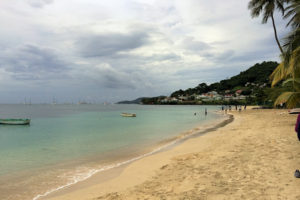
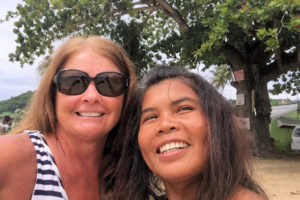
View from Umbrella’s Rose and Noi, after a few adult beverages

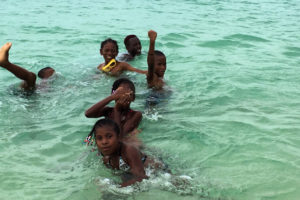
The Neumann family Local kids enjoying the water

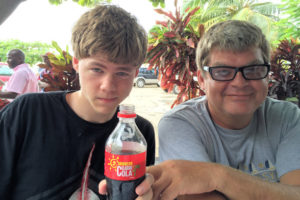
Flowers are everywhere in Grenada Caribbean Cola – actual Coke, but cheaper
Grenada and the Boat Parts Obsession
When Rosé came back from Colorado, she brought back a couple of boat parts. I had ordered a replacement tachometer for the dinghy (the original one died after the SXM incident), and we had a handheld radio for Scott. His had died under warranty, so he had a replacement one with a replacement invoice. Customs in Grenada is arbitrary at best. If you have a yacht in transit, you can get a form that allows you to bring parts in at a very low duty rate. The general duty exemption in Grenada is very low, at EC$300 – apparently it hasn’t changed in many years, despite inflation. The exemption applies to imported goods – it does not say, “except boat parts”. But we had heard from other boaters that the customs officers at the airport always ask if you are bringing in boat parts, and they sometimes charge arbitrary duty amounts. Before leaving, we visited the customs office at the marina, and they confirmed that the exemption was inclusive of boat parts. In addition, Rosé had created a low-cost invoice for the tachometer by buying and returning a low-cost tachometer at an auto parts store. So, she had a $20 invoice for the tachometer, and a $0 replacement invoice for Scott’s radio.
However, she got one of those customs Nazis at the airport. She was asked if she was bringing anything to declare, so she was honest, and showed the invoices. But that officer was having none of it, and claimed that boat parts have no exemption. She did not have the C14 form with her that allows us to apply a 2.5% duty rate – we thought the two items would be exempt. The officer wanted to know what the value of the radio would be if purchased new. Rosé did not know, and explained again that per the invoice, there was no value. But still the officer demanded a value, so Rosé told her $80. The officer assessed a duty rate of 38%, but Rosé did not have that much cash on hand, so the officer simply took all that she had. The moral of the story is that there are no rules on importing boat parts.
Around this time, the Jobs yacht, Venus, stayed in the marina for a few days. I still thought it was a very strange design, but recognizable as an Apple design.
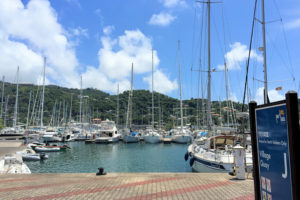
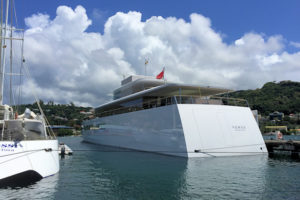
The docks at Port Louis Venus, the strangest yacht we ever saw
Hurricane Matthew Gives Us a Scare
One of the prime reasons that Grenada is a popular summer place for boaters is the scarcity of tropical storms. Few storms venture as far south as Grenada – only three hurricanes hit Grenada in the past fifty years. During August, Cape Verde hurricanes develop from tropical waves off of East Africa, and they have a relatively predictable pattern. As the end of September approached, a large tropical wave moved off of the coast of Africa, with tropical storm force winds. But since there was no closed center. The five-day forecast looked frightening – it showed Tropical Storm Matthew heading right over Grenada. We assessed our situation, and it wasn’t good. All of the boats on our dock were med-moored to something on the sea bottom, but we had no idea how strong the blocks were. We were jammed in very tight, with only fenders between us, so any significant winds could do a lot of damage. We kept monitoring the forecast, and it still had a bulls-eye on Grenada, but it was still a disorganized low.
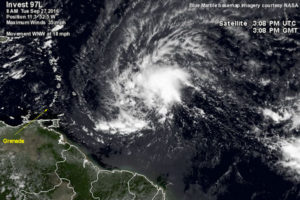
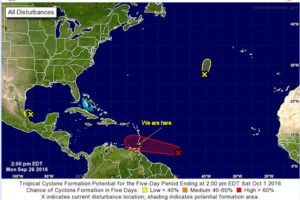
Even before forming, it was a big storm We were directly in the forecast path
From these pictures, the track and the size of the storm looked very scary. Everyone pulled their boats a few feet off of the dock, and added as many lines as possible. Symbiosis was at anchor in Prickly Bay, and the consensus was that they would have protection as long as the storm didn’t get too intense. Fortunately for us, by Sep. 28th, the track went north to Barbados. As it passed over Barbados, an eye formed, and Tropical Storm Matthew was born. It was already huge in area, and we did see winds of thirty-five knots, but there was no damage – whew! Shortly after passing over the Lesser Antilles, Matthew experienced rapid intensification, going from a tropical storm to a Category 2 hurricane in less than twenty-four hours. It became the first Caribbean Category 5 storm since 2007. It killed 603 people, and caused over $15B in damages. We had dodged Erica in 2015 and Matthew on 2016 – good fortune had smiled upon us.

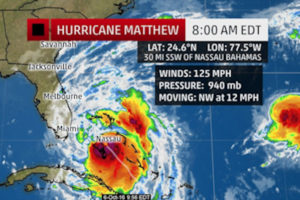
Storm track – it formed a little north of Grenada Threatening the USA mainland
Our Aussie Friends Visit
At the beginning of October, our friends Marty and Lynne from Australia came to visit us. We hadn’t seen them in ages. They used to live in the Bay Area with us, but had moved to Lynn’s home in Australia in 2010, and we had only seen them a couple of times since then. They were on a long vacation, and most recently had been in Cuba. They spent a week with us, and we took them on Cutty’s tour, as well as the beach, and of course, the West Indies Brewing Company.
We decided that we wanted to have the dinghy available to take Marty and Lynne around the harbor. By pushing our boats apart, John had manage to lower his dinghy, so I figured we could do the same thing. It wasn’t too hard, and the motor started quickly – a little surprising, since we had not used it for almost two and a half months. I wanted to run it out, so I took it out into the harbor entrance, when suddenly it shut way down. The motor was still running, but it was very rough. It would briefly catch and rev up, and then it would go back to a rough idle. I guessed that the fuel had gone bad. I limped back into the harbor, and I asked John to run me over to the gas station in his dinghy. Unfortunately, that did not solve the problem. John and I spent some time checking everything we could, but to no avail. I called in a mechanic, and the problem turned out to be something I could have easily fixed myself – bad spark plugs. D’oh!
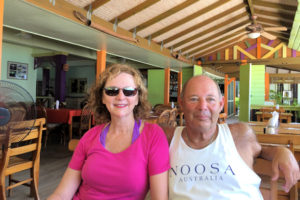
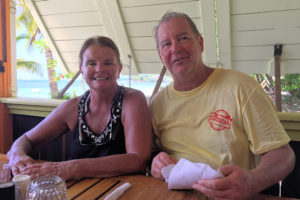
Marty and Lynne Relaxing at Coconut’s
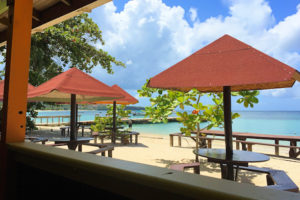
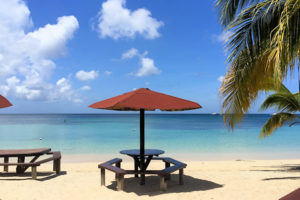
The view from Coconuts on a gorgeous sunny day
The island tour was the same as we had previously done with Cutty, but there were a few new things. We went with Debbie and John from Aftermath, along with their visitors – their niece Karen and her husband Josh.
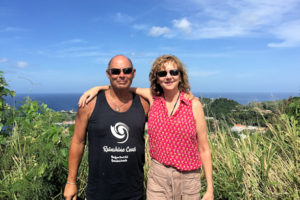
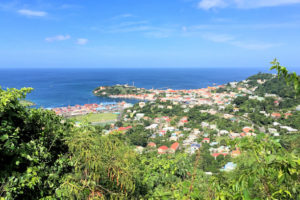
The view from the top of the hill
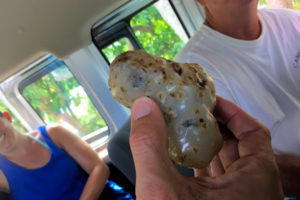
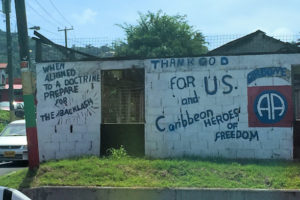
The somewhat disgusting noni fruit 33 years later
Cutty picked up a noni fruit to show us, and unfortunately, for us to smell. Noni is supposed to have a variety of medicinal properties, including lowering cholesterol and blood sugar. It is green on the tree, and then turns white as it ripens. It is said to have a “pungent” odor, but to us, it just plain stank. Cutty claimed that a wine made from noni is tasty, but there is no way…
The sign about the US invasion of Grenada was interesting. People on the island have two different views about whether or not the invasion was justified – Cutty doesn’t think so. Maurice Bishop, the Prime Minister who was assassinated during the coup, is now a revered figure in Grenada. If you are so inclined, Scott wrote a detailed entry about the invasion and the aftermath in his blog.
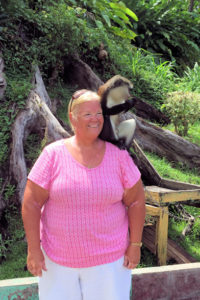
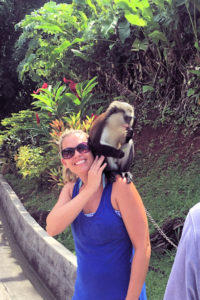
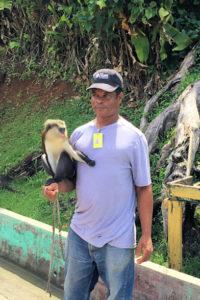
Debbie and friend Karen and friend The monkey master
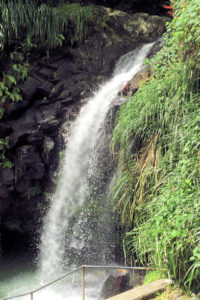
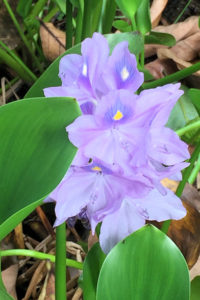
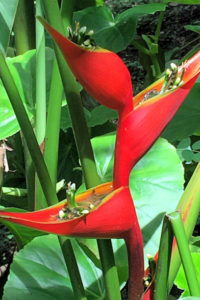
More pictures from beautiful Annandale Falls
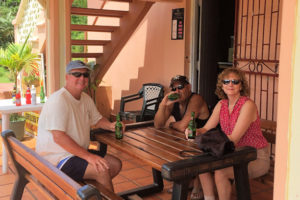
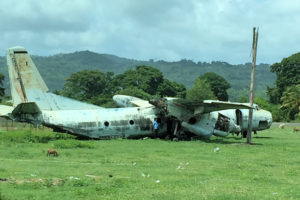
The bar at Grand Etang Wreck of Cubana de Aviacion plane
At the Grand Etang Park, we again failed to get the attention of the wild monkeys, so we hit the bar instead. Coming down off of the mountain, we literally drove through the old airport (now used as a drag strip) where the remains of a Cuban airliner and Maurice Bishop’s airplane are rusting away in the jungle.
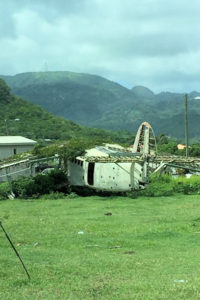

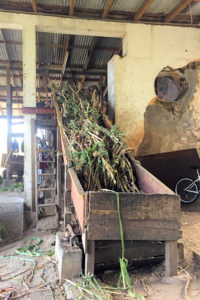
Maurice Bishop’s plane Debbie got a jungle bouquet Crushing cane
The distillery was in full operation that day, so we could see each step as it happened – crushing cane, boiling the can juice, fermenting the syrup, and distilling. They weren’t bottling anything at the time, however. At the tasting, we watched Karen make the most incredible face as she tried a sip of the 175 proof rum – sadly, no one had a camera on her at the time.
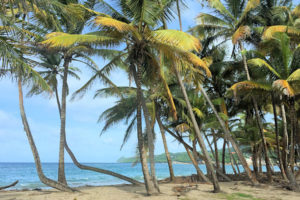

View from the Petit Anse Hotel John, Karen, Debbie, and Josh
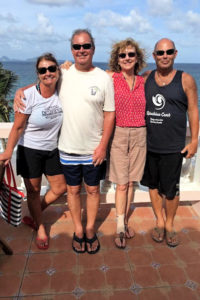 We took a different route to return to Port Louis, this time going around the north and west sides of the island. On the north side, we stopped at the Petit Anse Hotel, which offers a great view north towards Carriacou.
We took a different route to return to Port Louis, this time going around the north and west sides of the island. On the north side, we stopped at the Petit Anse Hotel, which offers a great view north towards Carriacou.
We drove through the town of Gouyave, which is right on the coast, and it was a big thrill for John. Normally a very laid-back guy, John got excited as we approached Gouyave, as he loves the insanity of the traffic as you go through the town. It seemed kind of typical to us, but he got a charge out of it.
Finishing the drive, we went around Halifax Harbour, which hosts the island’s garbage dump as well as the largest concentration of lionfish, and finally through Dragon Bay, which is the closest land to the underwater sculpture garden.
Between the island tours and the hikes we took, the variety of the plants, spices, nuts, and fruit on the island were simply amazing. Just across the street from the marina was a small restaurant called Patrick’s that focused on local food. We went over one night for tapas, consisting of over twenty specialty dishes. There were soups, vegetable, and meat courses, including rabbit and goat, as well as some deserts. During our visit we discovered new fruit including soursop, breadfruit, cerasee, chenet, five finger (star fruit), guinet, kusu (fruit of the cashew tree), sapodilla, sugar apple, water apple, and zaboca. The forests of Grenada have an incredible amount of edible plants in them.
Sculpture Garden
On the north side past St. George’s Harbour is the Underwater Sculpture Garden. You can take a tour boat to it, but it is also reachable by dinghy. We joined the Aftermath group in a two-dinghy flotilla, and we dove to find the sculptures. The visibility wasn’t fabulous that day, so it took a little time to locate the sculptures, but find them we did.
From the Wikipedia page:
“The Sculpture park, which began construction in 2006 is situated on the sandy ocean floor in the barren Molinere Bay and it now acts as an aid to relieve pressure on natural reefs which have become popular among water sports enthusiasts, particularly in nearby Flamingo Bay which is the most visited snorkeling destination on the island. There are over sixty-five concrete individual sculptures covering an area of over 800 square meters and in total weigh around 15 tonnes in dry cement. There has been some debate as to the intention of the park and whether it was a dedication to the slaves that were thrown overboard during the journey through the Middle Passage from West Africa to the Americas. In response the artist says “It was never my intention to have any connection to the Middle passage. Although it was not my intention from the outset I am very encouraged how it has resonated differently within various communities and feel it is working as an art piece by questioning our identity, history and stimulating debate.”- Jason de Caires Taylor.”
The sculpture park is accessible via boat from the main port of St Georges (2 miles/3 km north of the capital) or Grand Anse Bay on the West coastline. The sculptures are situated in a variety of depths of water with a maximum of 12 meters, and the park is visited daily by scuba divers, snorkelers and glass bottom boats. Recently a local artist on the island has added new works to the sculpture park.
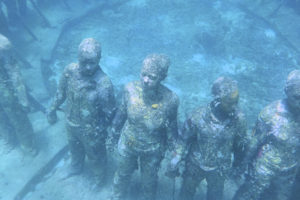
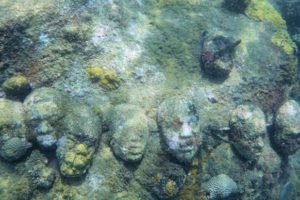
Closer view of Vicissitudes The Circle of Children
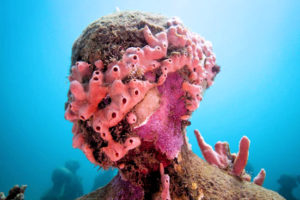
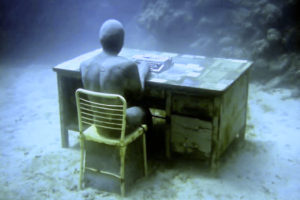
The reef is taking over The Correspondent

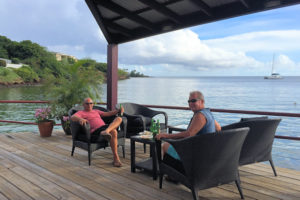
Views from the True Blue Resort
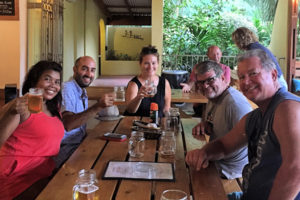

The gang at the WIBC We had a great time in Grenada
Grenada markets
The island has a lot of fresh markets. In St. George’s there are daily produce markets, as well as a fish market, and on Fridays and Saturdays, a meat market. At the fish market, all fish is priced at EC$8 per pound – about US$3. There was an ample supply of tuna, and on most days, wahoo, snapper, and other local fish. Surprisingly, we rarely saw mahi-mahi. We probably picked up fresh fish at the market weekly, for either sashimi or the grill. Across the street was the meat market. We first found it when we were walking back from the mango festival, and I got nicked by a flying bone. Inside there are fresh sides of beef hanging, with anxious local butchers waiting to cut it using machetes and hammers. It looked pretty good, so I request ribeye. I got meat on a rib, but I had to do a lot of trimming on it. While it was okay for slow cooker and stir fry recipes, it was too tough to make a good steak. Still, being in the market was quite the experience, sort of like a novel set in the third-world. We were surprised that there were no flies to speak of.

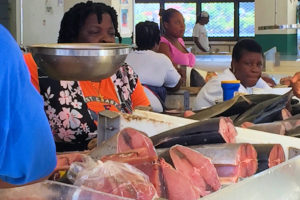
The fish market Lots of big tuna
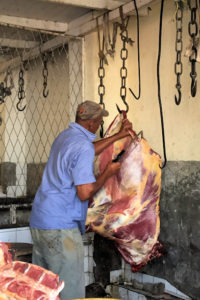
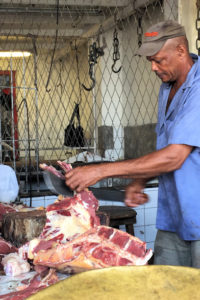
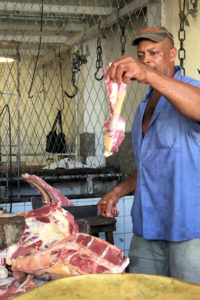
From a side of beef to a ribeye in no time flat
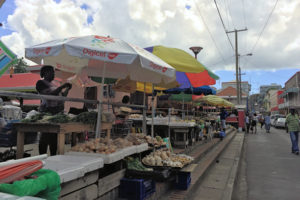
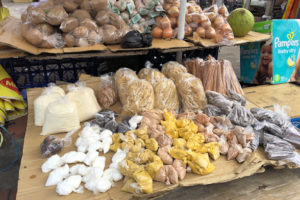
The downtown produce market was open every day
Wrapping up our Grenada stay
After Marty and Lynne departed, we still had the dinghy in the water, so we ventured south with Debbie and John to a snorkeling destination and a bay that was full of starfish. The beach was Mourne Rouge, around the point south of Grande Anse. There weren’t too many fish, but the coral formations were beautiful. On the ride back, we got hit by a squall with big raindrops. It’s amazing how much rain can hurt you when you are in an open boat doing twenty-five knots.
Before we could leave, we actually had to get visa extensions. Our original visas were good for ninety days, but we had to renew them – not at the convenient immigration office in the marina, but up the hill before St. George’s at the main office. Those of us that had not left the island during our stat had to go up there and pay an additional $25 for another month. Before we left, we brought over a picnic table behind our boats, and joined by Scott and Noi, we had a great lobster feast.
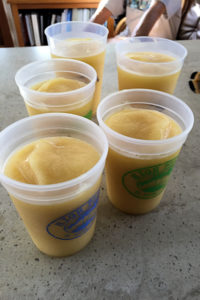
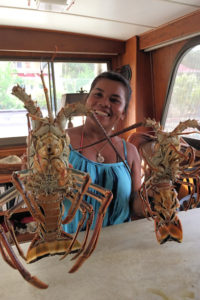
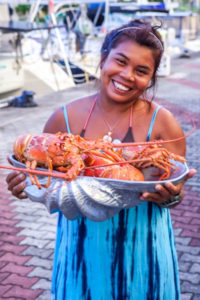
Lots of Tropical Blends Big boys Yummy!
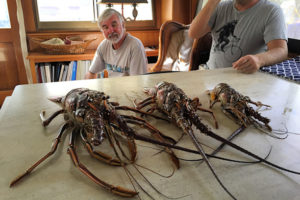
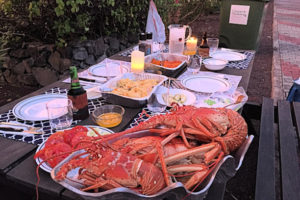
John and Scott guarding the lobsters The table is set




